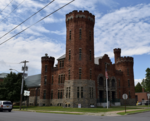Robert C. McEwen United States Custom House
1810 establishments in New York (state)Buildings and structures in St. Lawrence County, New YorkCustom houses in the United StatesCustom houses on the National Register of Historic PlacesGovernment buildings completed in 1810 ... and 2 more
Government buildings on the National Register of Historic Places in New York (state)National Register of Historic Places in St. Lawrence County, New York

The Robert C. McEwen United States Custom House, also known as U.S. Customshouse, is a historic customshouse building located at Ogdensburg in St. Lawrence County, New York. It was built in 1809-1810 as a store and warehouse. It is a two-story, utilitarian, gable roofed, stone bearing wall structure approximately 60 feet wide and 120 feet long. The Federal government purchased it in 1936 and converted it for use as a customshouse. It is the oldest within the building inventory of the General Services Administration.
Excerpt from the Wikipedia article Robert C. McEwen United States Custom House (License: CC BY-SA 3.0, Authors, Images).Robert C. McEwen United States Custom House
Catherine Street, City of Ogdensburg
Geographical coordinates (GPS) Address Nearby Places Show on map
Geographical coordinates (GPS)
| Latitude | Longitude |
|---|---|
| N 44.697222222222 ° | E -75.497777777778 ° |
Address
Catherine Street
13669 City of Ogdensburg
New York, United States
Open on Google Maps






